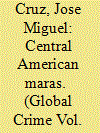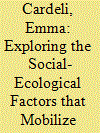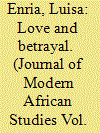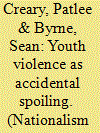|
|
|
Sort Order |
|
|
|
Items / Page
|
|
|
|
|
|
|
| Srl | Item |
| 1 |
ID:
099865


|
|
|
|
|
| Publication |
2010.
|
| Summary/Abstract |
Most of the empirical research on Central American street gangs, called maras, has been published only in Spanish. Reviewing that literature, the American scholarship on gangs, and my own research on Central American gangs from the mid-1990s, this article depicts the processes through which the maras (Mara Salvatrucha and the Eighteenth Street Gang) evolved from youth street gangs in the late 1980s to protection rackets with features of transnational organisations. Intense migratory flows between El Salvador, Guatemala, Honduras, and the United States, and the hard-line suppression policies against youth gangs in institutionally weak Central American countries created the conditions that prompted networking and organisation among Central American street gangs. This article highlights the changes in the dynamics of violence and the transformations in the gangs' social spaces to illustrate the evolution of the maras.
|
|
|
|
|
|
|
|
|
|
|
|
|
|
|
|
| 2 |
ID:
188033


|
|
|
|
|
| Summary/Abstract |
This article applies the social-ecological model to children’s mobilization into two violent groups—Central American gangs and terrorist organizations. While these two groups clearly differ in important ways, there are contextual similarities that frame a child’s involvement in each. For example, both flourish in low-resource settings where governmental structures may have been weakened or disrupted. Does it follow, therefore, that similar processes are at play in relation to children engaging in violent groups? This paper seeks to answer this question, reviewing available literature on the social-ecological factors that promote engagement in each group. Points of convergence and divergence between the groups are identified, and implications for prevention and intervention efforts are explored.
|
|
|
|
|
|
|
|
|
|
|
|
|
|
|
|
| 3 |
ID:
146129


|
|
|
|
|
| Summary/Abstract |
Youth unemployment is often presented as a security risk in post-conflict countries, yet the relationship between labour market exclusion and engagement in violence remains little understood. This paper opens up one aspect of this relationship, analysing how the employment aspirations of Sierra Leone's marginal youth relate to their decisions to take part in political unrest. Telling the stories of urban youth involved to varying degrees in violent episodes shows how violence is used as a tactic to signal loyalty to political strongmen. Such loyalty is hoped to result in the establishment of relations of reciprocity that will offer a road to socially valued employment. Comparing the experiences of two groups of young people, similar in their socio-economic background and experience of violence but different in their collocation in political networks, reveals two things. Firstly, availability for violence was insufficient to achieve durable incorporation, as pre-existing social ties determined the nature of recruitment. Secondly, as even those embedded in politicians’ networks of reciprocity appeared ultimately unable to escape marginality, their experiences cast doubt on the expediency of using violence as a way into the labour market, making the exploitative nature of these relations starkly evident.
|
|
|
|
|
|
|
|
|
|
|
|
|
|
|
|
| 4 |
ID:
131990


|
|
|
|
|
| Publication |
2014.
|
| Summary/Abstract |
Northern Ireland's current period of relative peace and political stability has been varyingly attributed to large amounts of international economic development assistance and the funding of grassroots peacebuilding work. Yet the post-accord peace is punctuated by seemingly sporadic and isolated acts of violence perpetrated by young people. Using the concept of accidental spoiling, we analyze the perceptions of 120 community group leaders and international funding program administrators pertaining to the causes and effects of persistent sectarian violence among Northern Irish youth and the effect of that violence on the long-term sustainability of peace in Northern Ireland. The views shared by this cross-section of civil society groups suggest that, although economic development assistance has provided opportunities to decrease the inequalities that contributed to the ethnopolitical conflict, low self-esteem, and low self-image, disrupted communities continue to fuel youth interest in violence, thereby raising the potential to harm the peace process. The article concludes by proposing that deeper social reorganizing objectives should be aimed for if Northern Ireland is really to achieve conflict transformation.
|
|
|
|
|
|
|
|
|
|
|
|
|
|
|
|
|
|
|
|
|